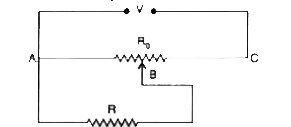A proton and an α particle are accelerated through the same potential difference V. The ratio of their de Broglie wavelengths is Solution in Kannada
λ=hp=h√2mqV
As mα=4mp and qα=2qp
λαλp=√2mpqp2mαqα=√mpqp4mp2qp=√18
=12√2
Topper's Solved these Questions
- BOOK - OSWAAL PUBLICATIONCHAPTER - DUAL NATURE OF RADIATION AND MATTEREXERCISE - TOPIC-2 DE-BROGLIE RELATION (SHORT ANSWER TYPE QUESTIONS-II)2videos
DUAL NATURE OF RADIATION AND MATTER
- BOOK - OSWAAL PUBLICATIONCHAPTER - DUAL NATURE OF RADIATION AND MATTEREXERCISE - TOPIC-2 DE-BROGLIE RELATION (LONG ANSWER TYPE QUESTIONS)1videos
DUAL NATURE OF RADIATION AND MATTER
- BOOK - OSWAAL PUBLICATIONCHAPTER - DUAL NATURE OF RADIATION AND MATTEREXERCISE - TOPIC-2 DE-BROGLIE RELATION (VERY SHORT ANSWER TYPE QUESTIONS)8videos
DUAL NATURE OF RADIATION AND MATTER
- BOOK - OSWAAL PUBLICATIONCHAPTER - CURRENT ELECTRICITY EXERCISE - TOPIC-3 (POTENTIOMETER & APPLICATIONS) (NUMERICAL PROBLEMS)2videos
CURRENT ELECTRICITY
- BOOK - OSWAAL PUBLICATIONCHAPTER - ELECTRIC CHARGES & FIELDSEXERCISE - (TOPIC -2)Numerical Problems5videos
ELECTRIC CHARGES & FIELDS
Similar Questions
An electron and a photon each have a wavelength of 1.00 nm. Find (i) their momentum (ii) the energy of the photon and (iii) K.E of electron
02:46View SolutionWhat are matter waves? Derive an expression for the de Broglie wave length.
02:16View SolutionA proton and an electron have same kinetic energy. Which one has smaller de-Broglie wavelength ?
02:11View SolutionA resistance of RΩ draws current from a potentiometer. The potentiometer has a total resistance R0Ω.A voltage V is supplied to the potentiometer. Derive an expression for the voltage across R when the sliding contact is in the middle of the potentiometer.
 03:33View Solution
03:33View SolutionAn atom was earlier assumed to be sphere of radius a having a positively charged point nucleus of charge +Ze at its centre . This nucleus was believed to be surrounded by a uniform desity of negative charge that made the atom neutral as a whole.
Use this theorem to find the electric field of this atom at a distance r(r>a) from the centre of the atom.02:59View SolutionA proton and an α - particle are accelerated through same potential difference. Then, the ratio of de-Broglie wavelength of proton and α-particle is
02:59View SolutionFind the ratio of de Broglie wavelength of a proton and as alpha -particle which have been accelerated through same potential difference.
02:59View SolutionAn α-particle and a proton are accelerated through the same potential difference. Find the ratio of de Broglie wavelengths.
02:04View SolutionA proton when accelerated through a potential difference of V, has a De-Broglie wavelength λ associated with it.if an α-particle is to have the same De-Broglie wavelength λ, it must be accelerated through a potential difference of
View SolutionA proton and an α particle are accelerated through the same potential difference V. The ratio of their de Broglie wavelengths is
03:01View SolutionA proton and an α particle are accelerated through the same potential difference V. The ratio of their de Broglie wavelengths is
02:56View SolutionA proton and an alpha particle are accelerated through the same potential difference . The ratio of the de - Broglie wavelength will be :
04:44View SolutionA proton and an alpha -particle are accelerated through the same potential difference. The ratio of de-Broglie wavelength of proton to the de-Broglie wavelength of alpha particle will be
04:01View SolutionAn α-particle and a proton are accelerated through the same potential difference. Find the ratio of their de-Broglie wavelengths.
02:15View Solutionएक प्रोटॉन तथा α- कण समान विभव से त्वरित किये जाते है। उनकी डी ब्रोगली तरंगदैर्ध्य का अनुपात होगा :
03:16View SolutionAn α-particle and a proton are accelerated from rest by the same potential, thenthe ratio of their de-Broglie wavelength is
View Solution

